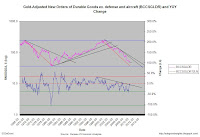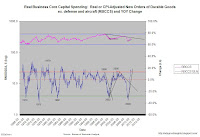 The ability to follow the money, see the secular trends despite the contradictory rhetoric emanating for media outlets, is usually the difference between long-term real profit and losses. The following is highly technical but it will provide a graphical representation of how gold market is managed.
The ability to follow the money, see the secular trends despite the contradictory rhetoric emanating for media outlets, is usually the difference between long-term real profit and losses. The following is highly technical but it will provide a graphical representation of how gold market is managed.The money flows in the gold market reveal a classic footprint of price management. The use of paper to slow the advance and setup leverage profit before price acceleration phases. The footprint in 2010, as I have written about on jsmineset.com in 2008-2009, is similar to that of 2005 and 2006.
Once "connected" money had reduced their net short position as a percentage of open interest from -50% to -17.58% from August 2005 to June 2006, thereby repositioning the trading computers and gold community, gold’s rally accelerated from $647 to $1,006.75 between June 2006 and March 2008. "Connected" money is attempting a similar net short reduction in 2010. Management of gold, however, should prove far more difficult in 2010. The economic and financial backdrop is far more fragile than 2006 and global investors are becoming increasingly aware to lie and deny tactics.
Gold London P.M Fixed and the Commercial Traders COT Futures and Options Net Long As A % of Open Interest:

Commercial traders, or connected money, manage the gold market. After the May 2005 high, connected money began the process of reduction their net short position into weakness to prepare for the next rally. The bulk of this churn was completed by 6/26/07 with an extremely bullish WA reading of 100%. Gold was trading at $647. Less than nine months later gold has soared to $1,006.75. A similar churn created by fear is unfolding today. The plan is to squeeze the trading boxes and retail money into weakness as cover to reduce short positions before the next price acceleration phase.
Gold London P.M Fixed and the Commercial Traders COT Futures and Options Stochastic Weighted Average of Net Long As A % of Open Interest:

Retail money, motivated by fear generated by price weakness, was driven from net long to short position from June to October of 2006. A similar money flow setup or “play” orchestrated by connected players is being executed in 2010. Retail money is in the process of being driven from net long to short positions from April to July-August of 2010. A break of the orange downtrend, as indicated by the blue arrow in 2006, will mark an end to the paper operation and the fleecing of retail money in 2010.
Gold London P.M Fixed and the Nonreportable Traders COT Futures and Options Stochastic Weighted Average of Net Long As A % of Open Interest:

The fear created during the churn driven away investors. This is illustrated by shrinking opening interest. Connected money decreases the net short (increases their longs) and control a larger position of the open interest. The sheep, trading computers and retail money, are lined up for the slaughter and are happy to be there.
Gold London P.M Fixed and the COT Futures and Options Open Interest Stochastic Weighted Average

Options are one of the preferred tools of management. The heavy churn created by fear within the D-wave wave often hides the money flows within the options market. Once heavy selling ends, illustrated by a break of the orange trend line after an extreme reading, connected money begins buying aggressively into weakness (call buying). This will mark the end of the D-wave and set the stage for lighter churn that will organize into a sharp, unexpected advance.
Gold London P.M Fixed and the Commercial Traders COT Options Stochastic Weighted Average of Net Long Options As A % of Open Interest:












































